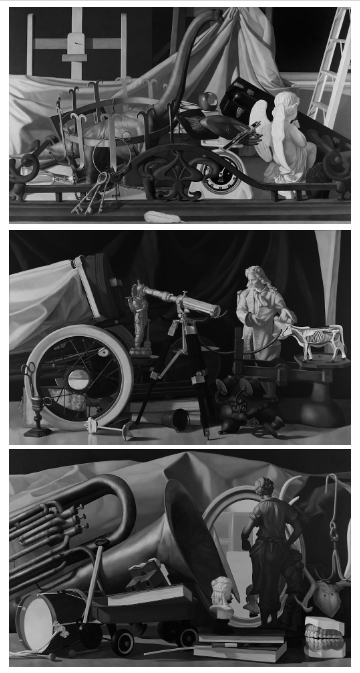Trilogy: God, King, Country
Natee Utarit
Black and white print on Hahnemuhle canvas - 2011
In collaboration with Krisada Suvichakonpong | Triptych, each panel 100 cm x 170 cm

Trilogy: God, King, Country, (2011) is a set of black and white canvas prints based on Natee Utarit’s eponymous paintings. Natee's paintings were sold individually so only this set of prints now reflects the artist’s complete conceptual premise.
These works belong to his Illustration of the Crisis series of 2010-2012 in which Utarit explored the allegorical language of classical painting to express “the complexity of modern issues and multifarious nature of ‘truth’ today.” The series was intended to subtly convey the public’s widespread unease caused by political turmoil in Thailand during this time. Staging various figurines, toy animals, religious icons, and everyday objects into complex tableaus, the artist contemplates the pillars of the modern Thai nation -- God, Country, and King. Because direct criticism of these institutions is considered taboo in Thailand, the use of symbolism and metaphor was necessary, from both an artistic and practical standpoint.
In the first panel, God, religion is symbolised by the sauropod trapped within a metal crown on which a set of keys dangle. It suggests that the means of unlocking the contradictory nature of Thai Buddhism is by understanding its long-standing ties to the monarchy which has politicised religion to justify its power. A steel ladder stands on one side, symbolising how the spiritual pursuit of heaven or nirvana has been neglected. On top of a scale sits a severed hand holding a crucifix, a reference perhaps to the religious justification for acts of violence by the state as “bad karma.” The apple that lies on top of a book refers to the karmic importance of sin vs. knowledge, in that the karma of a person’s deeds in his past, present, or future lives lasts forever. A small white feather at the bottom of the painting signifies virtue at the fringe of religion, for in its current state, religion lacks the moral weight it once carried.
In the middle panel, King, Natee has included objects such as a golf bag, a telescope, books, and a scale. These objects denote the elevated status and lifestyle of the monarchy and the elites surrounding the royal family. The inclusion of the telescope and a statue in Western dress is a historical reference to past sovereigns, particularly Rama IV, who embraced Western education and introduced modern science to Thailand. The stack of books and the anatomical model of the cow also represent the introduction of modern education and sciences to the country, which have contributed to its present economic prosperity. However, education is used by elite classes to maintain their status and to discriminate against the underprivileged. The fallen light sconce returns us to the Buddhist notion of life’s fragility and impermanence, hinting that even glorious reigns must come to an end as monarchs succumb to the inevitability of illness and death.
The last panel, Country, recounts the Thai national anthem which was composed in 1939 after the country changed its name from Siam to Thailand. A massive tuba dominates the painting, alluding to the anthem’s valorisation of death as the ultimate sacrifice for the country’s safety, freedom, and progress but the drum and sticks that have been abandoned on the floor suggest that the citizens are no longer prepared to take up this challenge. The meat hook that hangs on one side is a reminder of the tragic student massacre and hanging of left-wing activists in 1976 at the hands of state forces. The set of chattering teeth symbolises the dissatisfied voices of the people. Natee also plays with the idea of image in this work, as symbolised by the obscured reflection of the toy figure in the mirror and the toy viewfinder. The artist alludes to the importance of “face”, facades, and beautiful images in Thailand, where the messiness of politics and social unrest is carefully hidden from view and cannot be discussed openly. The entire tableau is set against a brown paper backdrop that references the working class people upon whose toil the nation has prospered but are always relegated to the background.

Subscribe and Stay Updated with us!
If you like to stay updated on the latest news about the collection, please enter your emai.
